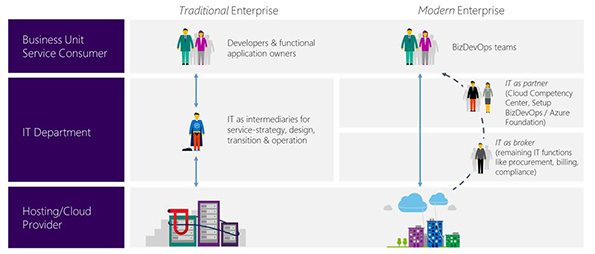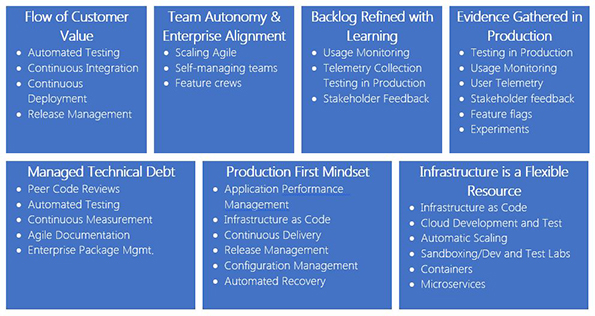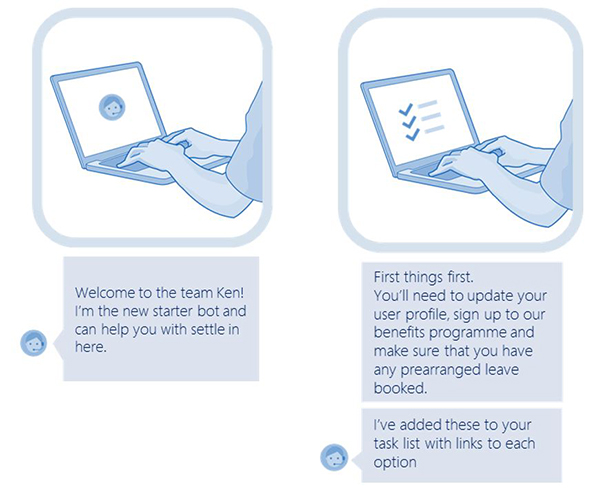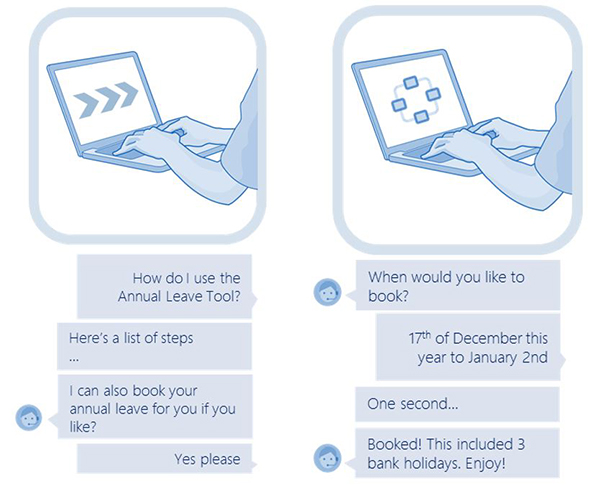Date Published August 15, 2017 - Last Updated December 6, 2017
If the rate of change on the outside exceeds the rate of change on the inside, the end is near. – Jack Welch
In Next-Generation Service and Support in a Mobile-First, Cloud-First World, Part 1,” I highlighted a number of challenges with current service and support models, which, if not mitigated, are simply amplified as a result of enterprise modernization and digital transformation taking place today.
In this article, I provide observations, projections, technology outcomes, and capabilities, that will impact IT service and support. The future of service and support is and will be shaped by at least four major trends currently underway:
- Consolidation of “Service and Support” across the enterprise
- Cloud-driven modernization/commoditization that reduces the demand for service and support
- Increasing knowledge of employees and associates and greater desire to automate/self-serve
- Technologies allowing greater service and support demands to be handled without human intervention.
John is presenting "Next-Generation Service and Support in a Cloud-First World" at the HDI 2017 Conference & Expo.
Consolidation of Service and Support
Businesses of all sizes and types are seeing the value of incorporating “Service and Support” to a single focal point across their organization. The argument is rather simple. Employees and associates shouldn’t have to figure out where to turn to get support not only for IT, but with HR, legal, and facilities scenarios, just to name a few.
Recent research on employee self-service indicates the challenge for organizations is to make knowledge accessible and easy for employees to solve issues on their own. According to current research, 44% of the time employees cannot find the answers they are looking for, and 61% of employees have to access four or more systems on a regular basis when looking for information. With proper knowledge management, automation, and training, an organization can staff a single service and support organization to address dynamic and diverse requests and workloads.
Consolidating service and support functions across the organization to one focal point results in the following outcomes:
- Reducing “redundancy taxes” for organizations with duplicative support organizations.
- Reducing the cost and time of employees and associates in need of service and support by not requiring them to know or have to search for appropriate support avenues.
- Providing improved cross-organization coordination, automation, workflow and integration to provide more seamless service and support to associates and employees.
- Increasing employee productivity. With quick access to consistent and organized knowledge, you can boost employee productivity significantly. In The State of Knowledge Management: 2014 survey report, 40% of employees said that productivity could increase by 20% to 30% with effective knowledge management.
- Improved customer satisfaction. When employees have access to the right answer at the right time, customer questions are answered faster and effectively. Customer satisfaction is sure to rise when their issues are solved quickly and without multiple interactions.
- Reduced service effort. By providing employees with an effective knowledgebase, you are deflecting questions from a high cost channel (live person) to a more cost-effective channel (self-service), reducing assisted-service costs.
- Enhanced products and services. By analyzing knowledge queries you can understand common customer questions and issues and use this knowledge to improve products and services. Customers are better served when improving and tailoring products and services to their needs.
- Support of corporate compliance. By making knowledge available to all employees, organizations can reinforce the adherence to policies and procedures, avoiding costly liabilities.
Several IT analyst groups have concluded and predicted similar findings as a result of increased cost pressures on IT organizations, as well as the need for improved service and support.
Cloud Modernization, DevOps/Agile, Modern Applications
Properly trained service and support personnel should and can have greater visibility and troubleshooting tools for cloud applications and services. Telemetry can and should be available to anyone as well as automation options. Improvements resulting from modern DevOps practices have demonstrably resulted in a decrease in failure demand that often drives costs in service and support.
The concept of DevOps (which is encapsulated within Modern Service Management) drives accountability of application and system support to the developers that created it or manage it. For example, a software factory model establishes a rotation of release-related staffing available for support with current and current release plus 1 (mixed-mode environment). Teams rotate in and out of support roles for the releases that are current. By following this and other DevOps practices, organizations have realized considerable value from establishing continuous release pipelines. Defects and errors are caught earlier and any that do make it to production are not as impactful.
Results from the 2016 State of DevOps Report provides astounding statistics and results from organizations adopting DevOps practices. As failures in production are reduced, efficiencies and quality improved, and experiences transformed (including in-application telemetry and support that targets developers or software vendors that provide the application directly), the need for failure related issues drops in service and support. Here are some key observations highlighted in the 2016 State of DevOps Report:
- 70% of CIOs indicated a willingness to increase risk to reduce IT costs and accelerate business agility.
- A bug caught in production costs 100 times more than the same bug found earlier in the development cycle.
- It takes 200 minutes on average to diagnose and repair a bug in production.
- High performing teams deploy more frequently and have much faster lead times:
- 200x more frequent deployments
- 2,555x shorter lead times
- Along with the greater number of deployments, there are less failures, and recover times are reduced when failures do occur:
- 3x lower change failure rate
- 24x faster recovery from failures
- 50% less time spent remediating security issues.
- 22% less time spent on unplanned work and rework.
Other findings from other sources support this as well and are driving organizations to adopt Agile and DevOps approaches to application development, deployment and management, and operations resulting in reduced failure demand. This in fact should be the overall goal: a reduction in failure demand workloads and a reduction in staffing for manual and intellectually menial type tasks.
Does this mean laying people off and making staff redundant? Not necessarily, but it does mean that updated roles, knowledge, technical capabilities, and practices are needed to release legacy work effort and practices. Modern Service Management encourages service and operations staff transition into BizDevOps roles where they evolve from back-office, technology facing roles, to more business integrated representatives and brokers of IT service as shown below.

The diagram above exposes one of the many IT transitions that have been identified with Modern Service Management. As you can imagine, there are transitions across all legacy ITSM process areas that are enhanced or transformed through the Modern Service Management lens.
It starts with following seven DevOps habits that Microsoft has fine-tuned over the course of our own internal journey. Service and support teams aren’t external from this but should actually embrace them into current and new roles. Think about habits as strategic mindset changes that an organization (and everybody in it) has to adopt and actively live every day.

Learn more about Microsoft’s DevOps journey, and review "Our journey to DevOps."
Greater Sophistication of Employees and Associates
Millennials have grown up with technology, while former generations have had to learn it later in life. Millennials have driven the demand for social, mobile, and chat messaging and collaboration within enterprises, which has fortunately resulted in prior generations adopting those technologies as well.
The Millennials generation is unique from other generations in the fact that they’re the first “always connected” generation. This digitally savvy audience tends to have shorter attention spans compared to older generations and relies on digital to stay connected. According to Forrester Research, 83% of Millennials indicate they are multi-screen oriented compared to 56% of non-Millennials. In fact, 9 in 10 Millennials simultaneously use their computer while watching a big screen, according to a report by Nielsen. Multi-screen consumer behavior is changing. Our screens—televisions, computers, tablets, gaming consoles, e-readers, and mobile phones—have become more powerful than the sum of their parts. You think this doesn’t impact service and support?
While Millennials embrace new technology with little fear, virtually all employees today are far more sophisticated when it comes to IT than they were 20 years ago and prefer personal technology and personal preference when it comes to service and support. The digital workplace is changing for Millennials and non-Millennials alike, yet service and support isn’t evolving to address this:
- Recent studies have shown that approximately 61% of workers still find it difficult to establish collaboration sessions with colleagues.
- Workers lose about 3.5 hours a week waiting for information from others.
- The workforce will continue to become more fragmented outside the office. According to IDC, the US mobile worker population will grow at a steady rate, increasing from 96.2 million in 2015 to 105.4 million mobile workers in 2020.
- By the end of the forecast period, IDC expects mobile workers to account for nearly three-quarters (72.3 percent) of the total United States workforce.
- By 2018, over 2.5 billion smartphones will be in use globally.
Regular employees, once requiring so much kid-glove treatment from IT, will now in some cases be more IT-astute than the service and support staff that is supposed to support them.
Another facet of this new Millennial demand set is the rise of individual automation technologies in their work environment similar to what they have in their personal lives. Examples of this today include IFTTT (If*This*Then*That) and Microsoft Flow. These services allow individuals to create and tailor their own automation scenarios across many different services and technologies, based on their assigned roles and capabilities.
While not a full featured automation platform, these services provide simple, Web/GUI based, transaction-based automated workflow intended for end-users to help increase their own productivity. Those used to this sophistication in their home lives are learning it can have an equal impact on their work lives as well.
Cognitive Capabilities Impacting Service and Support
Perhaps the biggest impact to service and support will come from changes taking place in customer care, which invariably makes its way to IT and enterprise service and support. Self-service portals have been cited as the next step in service and support. While very important, some business verticals still require telephone or messaging-based support. Think about it. How are the following employees or associates going to utilize a self-service portal?
-
First responders. Police, fire and rescue personnel are often called upon at moment’s notice and cannot easily utilize a self-service portal until there is downtime, that only they can determine.
-
Customer facing retail employees. Most retail firms do not want their employees turning their back on a customer when they have issues.
-
Military personnel. Most likely won’t have the infrastructure, time, or challenge that is easily addressed with a self-service portal.
While deflecting some workloads and demand, self-service portals haven’t provided the results and outcomes in ITSM that were intended, often targeted at 80% deflection of call demand, and often falling far short of that goal.
Conversation as a Platform (CaaP) is a modern capability revolutionizing customer care. The driver and premise is simple. Despite the millions of apps available on mobile, web, or tablet devices, research shows that most human beings focus on a limited number of apps based on messaging with other human beings.

Conversation as a Service (CaaP) is not just an “instant message” chat based on simple fixed logic trees and responses. Bot technology for CaaP is conversational and intelligent. This means, a chat bot is an intelligent application that is capable of learning and can respond through different channels more like a human being than a computer:
Vision
- Distill actionable information from visual images
- Personalize experiences with emotion recognition
- Detect, identify, analyze, organize, and tag faces in photos
- Analyze, edit, and process videos within your app
Speech
- Convert speech to text and back again, and understand its intent
- Fine-tune speech recognition for anyone, anywhere
- Ability to know who’s talking
Language
- Detect and correct spelling mistakes within your app
- Learn and understand commands from users
- Easily parse complex text with language analysis
- Detect sentiment, key phrases, topics, and language from text
- Leverage the power of language models trained on web-scale data
Knowledge
- Explore relationships among academic papers, journals, and authors
- Contextually extend knowledge of people, locations, and events
- Add interactive search over structured data
- Provide personalized recommendations
Search
- Intelligent autosuggest options for searches
- Advanced image and metadata search
- Link users to robust and timeline news searches
- Trending videos, detailed metadata, and rich results
- Connect powerful search to your apps
It is anticipated that by 2018, half of all consumers will interact with cognitive computing on a regular basis. Live-agent service and support calls average anywhere from $6 to $12 per call, while an automated, interactive voice response (IVR) or interactive text response (ITR) interaction can be as cheap as 25 cents. Bots can respond to changes in demand quickly, learn, translate, understand language and sentiment, and most importantly, know when to engage a human being.
In the following example, a bot is interacting and assisting a human being with getting started at work, setting up annual leave, and then handing off to a live support person when it is unable to resolve a subsequent issue.
Ken has just joined Contoso and is provided with his new machine. When he logs in, he is greeted by the Contoso bot. The bot follows the Contoso business process for new starters and highlights the tasks he should undertake. These are added to his Office account along with links and guides. Ken has an issue booking his annual leave and reaches out to the bot.

The bot uses shared knowledge to provide the steps Ken needs, however the bot can also undertake these actions for him. Ken states his request in natural language which the bot can understand. The bot connects to centralized on premises systems and completes his holiday request.

Bots today are about to or have already passed the Turing test, developed by Alan Turing in 1950, to test a machine's ability to exhibit intelligent behavior equivalent to, or indistinguishable from, that of a human. You may have seen the Imitation Game where the Turing test was discussed during the interview scenes. Turing proposed that a human evaluator would judge natural language conversations between a human and a machine that is designed to generate human-like responses.
This technology impacts IT, enterprise and corporate service and support, and customer care by offloading intake tasks and automation not from a portal, but from a bot through IM, phone, or messenger app. Just imagine the possibilities of augmenting service and support workloads and scenarios with bot technology where a bot could handle (and potentially deflect) 30, 40, 50, perhaps even 60% of the workload?
The Future of Service and Support
The future of service and support is already being shaped by technologies such as the cloud, intelligent applications, and bot technology. The first step IT organizations should take is to recognize that current and legacy IT service and support models are failing the organizations they support. And it’s not always their fault. Customer obsession should be priority one. Managing, mapping, and monitoring services end-to-end provides telemetry and automation that improves employee or associate satisfaction by reducing the failure demand experienced in service and support. Consolidating service and support across the business versus having multiple diverse service desks drives consistency, quality, efficiency, and effectiveness as long as it is knowledge based, inherently automation and customer obsessed.
Current and legacy IT service and support models are failing the organizations they support.

Finally, technologies such as bot technology can change the economics of service and support that can allow expensive human resources to focus on those tasks that only human beings can do. IT organizations have the choice to react versus drive these business value changes within their organization to transform from being just cost centers to being business value drivers for their organization.
John Clark is an ITSM service management architect with the Microsoft Americas ITSM practice and a subject matter expert in the Modern Service Management Worldwide Community. In his current role, John is responsible for shaping opportunities with customers seeking to apply or enable ITSM improvements. John has received several honors in recent years, including being selected for the WW ITSM Communities SME Award, Microsoft Sr. Technology Leadership Program (2014), and the Americas Gold Club (2016). He is also a past president of the Ohio Valley itSMF USA LIG and a former LIG of the Year recipient. Connect with John on LinkedIn, and follow him on Twitter @CyberJMC66 and @MicrosoftITSM.